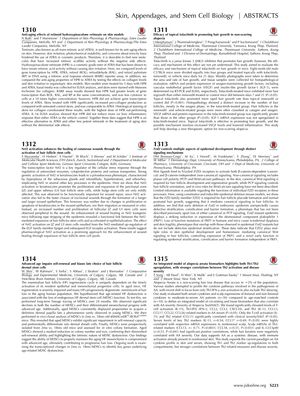Fzd2 Controls Multiple Aspects of Epidermal Development Through Distinct Signaling Mechanisms
April 2018
in “
Journal of Investigative Dermatology
”
Hydroxypinacolone retinoate Tretinoin Nrf2 hair follicle stem cell proliferation hair follicle dermal stem cells hair loss topical tofacitinib non-scarring alopecia VEGF Fzd2 epidermal development hair follicle formation alopecia areata Th1 cytokines Th2 cytokines HPR Retin-A vascular endothelial growth factor Janus kinase inhibitor JAK inhibitor

TLDR Fzd2 is important for skin and hair development through various signaling ways.
The document summarizes findings from various studies on skin and hair biology. Study 1310 suggests that Hydroxypinacolone retinoate (HPR) could be a non-irritating alternative to Tretinoin for aging skin treatment. Study 1312 indicates that activating Nrf2 can enhance wound healing by stimulating hair follicle stem cell proliferation. Study 1314 points out that aging negatively affects the self-renewal and differentiation of hair follicle dermal stem cells, leading to hair loss. Study 1311 shows that topical tofacitinib may promote hair growth in non-scarring alopecia by increasing VEGF levels. Abstract 1313 reveals that Fzd2 is crucial for various aspects of epidermal development, including hair follicle formation, through different signaling pathways. Finally, study 1315 presents an integrated model of alopecia areata biomarkers, noting an upregulation of Th1 and Th2 cytokines, with Th2 activation more strongly correlated with disease severity.




